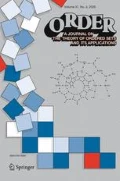Abstract
A poset P=(X,≺) is a split semiorder if a unit interval and a distinguished point in that interval can be assigned to each x∈X so that x≺y precisely when x's distinguished point precedes y's interval, and y's distinguished point follows x's interval. For each |X|≤10, we count the split semiorders and identify all posets that are minimal forbidden posets for split semiorders.
Similar content being viewed by others
References
Bogart, K. P. (1994) Intervals and orders: What comes after interval orders?, in V. Bouchitte and M. Morvan (eds.), Orders, Algorithms and Applications, Springer, Berlin, pp. 13-32.
Bogart, K. P., Fishburn, P. C., Isaak, G. and Langley, L. (1995) Proper and unit tolerance graphs, Discrete Appl. Math. 60, 99-117.
Bogart, K. P. and Isaak, G. (1998) Proper and unit bitolerance orders and graphs, DiscreteMath. 181, 37-51.
Bogart, K. P. and Trenk, A. (1994) Bipartite tolerance orders, Discrete Math. 132, 11-22.
Chaunier, C. and Lygerōs, N. (1992) The number of orders with thirteen elements, Order 9, 203-204.
Culberson, J. C. and Rawlins, G. J. E. (1991) New results from an algorithm for counting posets, Order 7, 361-374.
Doignon, J.-P. (1987) Threshold representations of multiple semiorders, SIAM J. Alg. Discrete Methods 8, 77-84.
Doignon, J.-P., Monjardet, B., Roubens, M. and Vincke, Ph. (1986) Biorder families, valued relations, and preference modelling, J. Math. Psychol. 30, 435-480.
Fishburn, P. C. (1985) Interval Orders and Interval Graphs, Wiley, New York.
Fishburn, P. C. (1997) Generalizations of semiorders: A review note, J. Math. Psychol. 41, 357-366.
Fishburn, P. C. and Trotter, W. T. (1998) Dimensions of split semiorders, Order 14, 171-178.
Fishburn, P. C. and Trotter, W. T. (1999) Split semiorders, Discrete Math. 195, 111-126.
Langley, L. J. (1993) Interval tolerance orders and dimension, Ph.D. Thesis, Dartmouth College.
Lygerōs, N. and Zimmerman, P. (2000) Computation of P(14), the number of posets with 14 elements, Published electronically at www.desargues.univ-lyon1.fr/home/lygeros/poset.html.
Pirlot, M. and Vincke, Ph. (1997) Semiorders, Kluwer Academic Publishers, Dordrecht.
Scott, D. and Suppes, P. (1958) Foundational aspects of theories of measurement, J. Symbolic Logic 23, 113-128.
Shull, R. and Trenk, A. (1997) Unit and proper bitolerance digraphs, J. Graph Theory 24, 193-199.
Sloane, N. J. A. (2000) The On-Line Encyclopedia of Integer Sequences, Published electronically at www.research.att.com/?njas/sequences/.
Trenk, A. N. (1998) On k-weak orders: Recognition and a tolerance result, Discrete Math. 181, 223-237.
Trotter, W. T. and Moore, J. I. (1976) Characterization problems for graphs, partially ordered sets, lattices, and families of sets, Discrete Math. 16, 361-381.
Wine, R. L. and Freund, J. E. (1957) On the enumeration of decision patterns involving in means, Ann. Math. Statist. 28, 256-259.
Author information
Authors and Affiliations
Rights and permissions
About this article
Cite this article
Fishburn, P.C., Reeds, J.A. Counting Split Semiorders. Order 18, 119–128 (2001). https://doi.org/10.1023/A:1011967426437
Issue Date:
DOI: https://doi.org/10.1023/A:1011967426437


